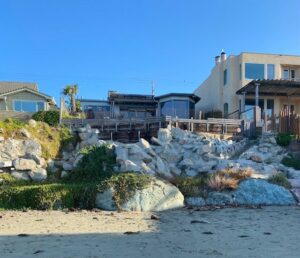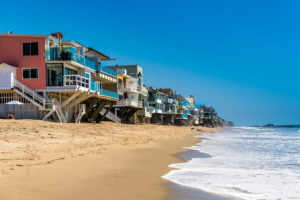PLF client heads to the California Supreme Court to protect his property from the CCC

The California Coastal Commission (CCC) has earned itself a nasty reputation for overstepping the boundaries placed on it by both the state legislature and local county laws. And many California homeowners have lost their property rights as a result.
Shear Development Company has experienced this abuse firsthand—so now they’re taking the Coastal Commission to the California Supreme Court.
Illegal power grabs
Careful to follow the proper protocols, Shear Development applied to San Luis Obispo County for a Coastal Development Permit before starting construction on the eight lots it owned in Los Osos, California. In 2004, the County granted their permits with the stipulation that the construction on the project was to be done in two phases. The permits allowed initial development work on all eight lots but authorized only four homes to be built in the first phase. In 2017, Shear went back to the County for the green light to complete development of three of the four remaining lots.
The County gave the go-ahead and, once again, everything seemed to be in order to proceed with the development project. That’s when the CCC got involved.
Out of nowhere, the CCC stepped in and appealed the County’s decision, denying the company the permits and rendering Shear unable to continue developing on the land.
The CCC claimed that it had enforcement power over the development project because the project was in a sensitive resource area (SRA). The Commission also asserted that it could appeal any permit in a zoning area that had more than one principally permitted use. If this absurd claim were followed to its logical conclusion, it would mean that the CCC has the power to appeal every single project within the county’s coastal commission zone.
Unfortunately for the CCC, the Coastal Act requires legislative adoption by the local government before land can be designated as an SRA. And that these areas must be clearly labeled on a designating map—which was never done.
Not to mention, the Act also prohibits the CCC from legislative acts such as designating sensitive habitats and restricts the agency’s appellate authority to review local government actions only for inconsistency with the certified LCP or Coastal Act.
To put it bluntly, the CCC does not have the authority to ignore or override the County’s permitting decision, but that didn’t stop the Commission from trying.
It might seem like a rather bold move for the CCC to claim so much authority when it is specifically prohibited from doing so. In truth, the Commission has been emboldened to make such grandiose claims because it has gotten away with it for decades. And in the case of Shear, the state courts dismissed the company’s lawsuit against the CCC, deferring to the Commission’s view of its own authority.
Pacific Legal Foundation is now helping Shear Development Company fight back to restore the legal limitations the CCC is trying to ignore. Earlier this month, the California State Supreme Court agreed to hear the case.
This case continues PLF’s longstanding efforts to force the CCC to adhere to California law and acknowledge that property owners in the coastal zone have the fundamental right to use and develop their own land. Luckily, PLF has an impressive track record of taking on the CCC.
Stepping in after the Commission’s years-long delay
A few years ago, Pacific Legal Foundation represented David and Stephanie Tibbitts, who had hoped to build a home on their oceanfront property in San Luis Obispo County, where they could spend their retirement. Their plan was to tear down the outdated 1930s home and rebuild a modern home in its place. As they made their plans, David suffered a stroke and was left confined to a wheelchair.
With their needs now changed, it became imperative for the couple to get the project underway and build a home that would be accessible for David’s wheelchair. As with Shear, the County had given the Tibbittses the permits to build … and then the CCC interfered in the process.
The CCC appealed the permits, claiming that they had jurisdiction over the Tibbettses’ property. The couple’s land is fronted by a “riprap revetment,” a type of seawall that helps protect against erosion. It includes a built-in staircase between the backyard and sand. The Tibbettses’ building plans took this into consideration and planned to leave their riprap intact to protect their shoreline and prevent damage to their neighbors’ seawalls. The County approved these plans, but the CCC had other ideas.
The California Coastal Act does not give the CCC the power to approve or deny improvements on riprap built before the Act was passed, as was the case with the Tibbettses’ property. Even so, two CCC commissioners fought the county’s decision and threw a wrench in David and Stephanie’s plans.
The two commissioners filed an appeal and the rest of the CCC got on board, placing the Tibbettses’ plans in a state of review purgatory. The review, mind you, was never something the CCC even had the power to enact.
The Tibbittses were now left to live in a home that was both falling apart and completely unsuitable to David’s needs. Meanwhile, the CCC dragged its feet on the review process, refusing even to schedule a hearing on the Tibbittses’ case. Months went by, then years. The Tibbittses’ attorney asked PLF to get involved. Only after PLF filed a lawsuit against the Commission on behalf of the Tibbittses did the CCC hold a hearing and approve the permit. The couple had been forced to wait for three years.
A year after the hearing, David Tibbitts passed away.
The Tibbettses’ plight was just another in a string of CCC abuses that PLF has challenged. In fact, Pacific Legal Foundation’s first Supreme Court win was in a case against the Commission.
‘Psychological barriers’
In 1982, Marilyn and Patrick Nollan started working on their dreams of adding a second story to their beachfront property in Ventura County. They had no idea when they filed the permit applications that the process would be a yearslong battle against the CCC.
When they applied for their permits, the CCC agreed to approve their application, with one major caveat. To get the building permit, the Nollans would have to sign away one-third of their property to the State through something called an “exaction.”
More outrageous than this demand was their reason for doing so.
The CCC said the Nollans’ expanded home would create a “psychological barrier” to the ocean for passing motorists by partially blocking their view of the water. To remedy the alleged psychological distress of beachgoers who would apparently forget where the ocean is if they couldn’t see past the Nollans’ second story, they would have to open their private beach for public access.
Eager to be done with the entire debacle and disheartened by the CCC’s formidable track record in court, the Nollans signed the permit agreement to give up part of their land in exchange for the right to build.
But that wouldn’t be the end of the matter.
The entire situation bothered Patrick. This was his property and the CCC had no right to twist his arm into giving away a chunk of it. Patrick happened to come across an old case in which the CCC actually lost an appeal. The case was argued by PLF. Patrick got in contact with PLF attorneys and decided to take on the CCC.
There was just one problem: PLF couldn’t take the case because Patrick had already signed the agreement. But Patrick had a trick up his sleeve.
His permit application hadn’t been processed yet. So he went to the California Coastal Commission’s office and told the secretary he messed up the application.
She handed him the unprocessed application, which he then took and ripped to shreds after exiting the building. Without the computerized records we have today, that paper application was the only record the State had against Patrick.
Patrick immediately called back PLF and said, “OK, I just ripped up my permit application. Will you take my case now?”
The Nollans won in trial court but lost in appellate court, and the California Supreme Court declined to take the case. In 1987, five years after they applied for the permit, Nollan v. California Coastal Commission went before the United States Supreme Court and the Nollans were finally vindicated. The Court didn’t just strike down the CCC’s demands for land as unconstitutional, it went so far as to call the demand an “out-and-out plan of extortion.”
The battle presses forward
These are just a few examples of individuals who have fallen prey to the CCC’s routine abuse of power against property owners.
But PLF will not back down until California restores every individual’s right to use their own property without interference from the CCC, especially in matters over which it was never given authority.
As the Shear Company prepares to go to battle against the CCC’s illegal actions, PLF is hopeful that the California Supreme Court will make the right decision and enforce the CCC’s legal limitations and protect property for all Californians.








